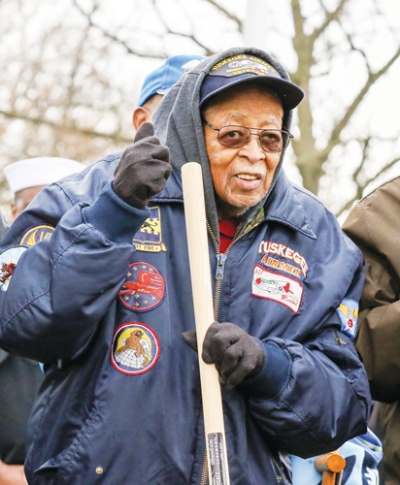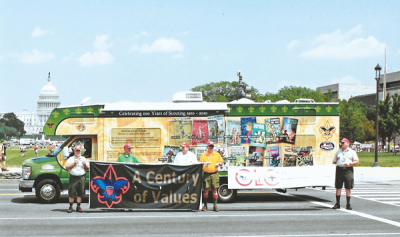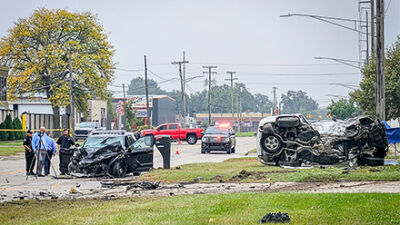
World War II veteran and Tuskegee Airman Alexander Jefferson, of Detroit, gives a thumbs-up during the Michigan World War II Legacy Memorial groundbreaking at Royal Oak’s Memorial Park on April 7, 2022. Jefferson will be honored as the namesake of the Lieutenant Colonel Alexander Jefferson Post Office at 155 Main Street in Mount Clemens.
File photo by Patricia O’Blenes
MOUNT CLEMENS — The Mount Clemens Post Office will soon become a monument to a trailblazing aviator who trained in the city’s backyard.
Signed into law on Oct. 10, the post office at 155 Main Street will be renamed the “Lieutenant Colonel Alexander Jefferson Post Office.” Jefferson was a member of the famed Tuskegee Airmen — the 332nd Fighter Group of the then-United States Army Air Corps — becoming one of the first Black Americans to serve as a pilot in the United States military during World War II.
A resident of Detroit since his birth in 1921, Jefferson joined the Army and entered the Air Corps because, according to Tuskegee Airmen National Historical Museum President and CEO Brian Smith, serving as a pilot had more lucrative compensation than serving in the infantry.
“He trained at Tuskegee Army Airfield at Moton Field and then went to bases to do his advanced training,” Smiths said. “For instance, Selfridge Air National Guard Base right here in the metro Detroit Area. Eventually, he was assigned to the 99th Fighter Squadron as a replacement and went overseas to fight the Germans.”
Jefferson and other pilots in the 332nd trained at Selfridge in part to acclimatize them to flying and navigating above open water.
“They were going to be going to Italy and flying in the Mediterranean where there’s a lot of water, and the climate was similar to that of Michigan,” said Steve Mrozek, director of the Selfridge Military Air Museum. “In 1943, they sent a lot of the pilots as they graduated up to Selfridge to get experience flying over a body of water for navigation purposes. There was a gunnery school up near Oscoda, and that’s where a lot of them went up and learned marksmanship there with their aircrafts.”
Along with gunnery training and navigational experience, Mrozek believes Selfridge was likely chosen as the advanced training base for Tuskegee Airmen due to a possibly more amenable environment for race relations, as opposed to the more segregated bases in the south or west. Unfortunately, racism in 1940s America was not a geographically locked issue, and Jefferson and his peers were barred by white officers from utilizing the Selfridge officers club. This manifestation of anti-Black racism was a common occurrence at the home front bases where the 332nd would find itself.
“As a pilot you are an officer, and Army regulation says you can go to the officers club and take advantage of all the amenities there,” Smith said. “Base commanders would prevent them from going to the officers club, and they would protest this.”
Smith says that being barred from the officers club was their height of racial issues Jefferson faced while at Selfridge for training. Being barred from officers clubs led to the Freeman Field Mutiny in April 1945, where future Detroit Mayor Coleman Young helped plan the integration of the Freeman Field, Indiana officers club. Numerous Black officers attempted to enter the club and be served, leading to over 100 arrests taking place.
The racism inherent to segregated units extended throughout the Army during World War II. All-Black combat units like the 555th Parachute Infantry Battalion and the 761st Tank Battalion were formed. White leaders within the military tended to look down on the idea of Black Americans fighting — in the case of the 332nd, officers saw the unit as set-to-fail experiment of the idea of Black Americans as fighter pilots — and many Black soldiers were assigned to support roles. The Red Ball Express convoys that supplied the Allied efforts in Europe were mainly operated by Black soldiers. Segregated units led to segregated bases as well, with Tuskegee Army Airfield being left as the only place where Black pilots would be trained. This led to fewer Black replacement pilots being able to relieve the ones fighting over Europe, causing Tuskegee airmen to fly 70 missions before relief rather than the standard 50 missions. The armed forces were integrated by an executive order on July 26, 1948.
“When your county treats you like a second-class citizen — and even sometimes like a boy when you’re a man — and you go and actually fight for your county, that takes a lot,” Smith said. “I don’t know how African Americans did that during World War II, volunteering to put their lives at risk for a county that did not love them nor treated them fairly.”
Over in Europe, Jefferson flew 18 missions behind the yoke of P-51 Mustangs. He was shot down over France during his 19th mission in August 1944, when he and other Tuskegee Airmen attacked German radar positions ahead of the invasion of southern France. Jefferson was captured by German forces and sent to the Stalag Luft III prison camp in Poland.
“He was treated very well, and they could trust him because they knew there were no African American Germans, therefore he could not be a spy,” Smith said. “When he was captured, the Germans interrogated him and knew more about him than he ever imagined. They knew who his father was, they knew the records of his father’s IRS tax payments, they knew Alex Jefferson’s class, where he went to high school, his grades; the Germans did a lot of research and knew who these guys were.”
By 1945, prisoners at Stalag Luft III were liberated and Jefferson returned to Detroit before the year was through. After working for the United States Postal Service for some time, Jefferson completed a master’s degree in education from Wayne State University and began his career as a public school educator. Jefferson taught science and was later an assistant principal at Pattengill Elementary School in Detroit, retiring in 1971. Jefferson helped raise the next generation of aviators by co-founding a Civil Air Patrol squadron with fellow 332nd airman Richard Macon and others.
Jefferson’s passion for aircraft was not only for full-sized planes, but miniature ones as well. Smith first met Jefferson while he was discussing the finer points of P-51 construction at a hobby shop.
“At the hobby shop, Alexander Jefferson was discussing a four-bladed propeller with the salesman,” Smith said. “I butted in the conversation, I was just a late teenager at the time, and I asked him why he wanted a four-bladed propeller for a P-51 Mustang. He looked at me and said,
‘Because I have a remote-control model.’ I said, ‘Why do you have a remote-controlled model of a P-51 Mustang?’ I was hoping this was one of the guys who flew during World War II, and he looked at me again and said, ‘Because I flew one in World War II.’”
Smith then introduced himself, informed Jefferson his father was also a POW at Stalag Luft III, and thus their friendship again. Jefferson was the first Tuskegee Airman Smith met and he would go on to meet many more through the work of the Tuskegee Airmen National Historical Museum. Jefferson served on the museum’s board of directors and was actively involved until his death in 2022 at 100 years old.
An educator throughout his life, Smith says the renaming of the Mount Clemens post office will continue Jefferson’s work of teaching and inspiring the pilots and engineers of tomorrow.
“What it does for an African American youth is, if they a bit of research about why this post office is named after Alexander Jefferson, they will find someone like them — same color, same race, same culture — who did great things for their country and be encouraged that they, too, can do it,” Smith said. “If you can see it, you can be it. That’s the importance of having this post office named after Alexander Jefferson. It puts forever in the air, ‘Here’s an African American who did something great for his country and his community, and you should be like him.’”
Another monument to Jefferson’s legacy is the radio-controlled airfield at Rouge Park in Detroit, renamed on his 100th birthday in 2021 to Jefferson Airfield.
The Tuskegee Airmen National Museum operates its educational programs out of the Coleman A. Young International Airport in Detroit, as well as having a collection inside the Charles H. Wright Museum of African American History in midtown Detroit. More information about the museum and its programs can be found at tuskegeemuseum.org.
 Publication select ▼
Publication select ▼






















